The Missing Link? the Heavy Tanker and Air Force C-124 Globemaster II Effect on the U.S. Airborne of the 1950s-60s

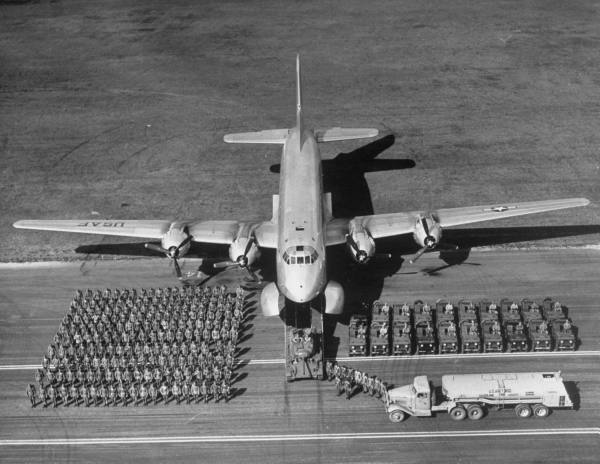
C-124 Tactical Load-out: 200 x airlanded troops or 1 x M24 Chaffee light tank or 20 x 4x4 jeeps or 4 x OH-13 Sioux Killer Bee light observation/attack helicopters
So what exactly did happen to the U.S. Army Airborne during the 1950s when it had powerful proponents like LTG James Gavin in charge of R&D?
Why didn't they light air-mechanize when clearly light tanks like the French AMX-13 with 75mm gun and the M50 Ontos with 6 x 106mm RR and armored personnel carriers like the T56 variant were available?
Heavy tankers don't want Light tanks
Immediately after the Korean war, LTG Gavin with his VISTA group proposed the 8-ton Ontos coupled with more purchases of C-119 Flying Box Cars to deliver them, but this was rejected despite it being well-suited for climbing steep terrains albeit slowly and could be heli-lifted as soon as a heavy-lift helicopter was fielded. The reason we suppose is that the heavy tankers who would own and operate the Ontos were not satisfied with its thin armor protection and gasoline power; which begs the question Gavin asked: "Where is the Cavalry?" Where are the groups of Soldiers willing to take RISKS to be the first ones to make contact with the enemy by lighter tanks to gauge the situation and help shape it to our advantage?
The answer is that the Airborne itself was and still is today the air (3D) Cavalry; and should have owned and operated their own light tanks but they have an embedded man-with-a-rifle bias against mechanization that takes glory away from the infantry. Thus, as long as the Airborne infantry insists on tankers of Armor branch to operate light tanks for them, there is going to be a break-down because they simply do not want to do it, justifying their commonly received insult of "mech pussy" because they want to remain a part of a heavy, "invincible" tank main body that can only fight in open terrains where the enemy is easily contrasted and targeted. That the Airborne is actually Cavalry can be seen in what happened to the 11th Airborne Division when it was the helicopter experimental unit in 1964; it was renamed the 1st Air Cavalry Division.
Thus, with a heavy tanker, armor branch reluctant to operate light tanks because it disdains the Cavalry function, the perfectly suitable AMX-13 and M50/M56 Ontos families were rejected in favor of a heavier replacement for the 18-ton M24 Chaffee light tank which was mechanically good but weak in firepower with the old Sherman tank 75mm gun. Keep in mind AMX-13s have since their introduction been up-gunned to 105mm guns that can kill most tanks today. That M24s could have been up-gunned to 105mm guns is moot point because its already been done by a NATO ally. Armor branch chose to replace their M24s with 23.5 ton M41 Walker BullDog tanks with mildly improved 76mm guns that we later saw were more than a match for Russian T-54/55s in Vietnam combat with the ARVN. M41Ds with 105mm guns and diesel piston engines are front-line combat vehicles in Taiwan today. Why we couldn't upgun them and get rid of the noisy, unsafe gasoline engines?--is a good question.
So there you have it; the Korean war ends (sort of) and the M41 replaces the M24 in a sort of Armor cranch fait accompli delivered to the Airborne: take it or leave it. The problem is that the M41 at 23.5 tons is too heavy for any USAF aircraft except the C-124 Globemaster II to lift. Enter the C-124 curse.
Air Force C-124s Don't Have Rear Ramps to ParaDrop Vehicles

The C-124 upon closer inspection can indeed carry a 23.5 (47, 000 pounds) M41 light tank and have fuel for 1, 385 miles if we assume 400 gallons/hour per engine times 4 of them. The problem is the M41 has to roll-on and off from the FRONT NOSE of the C-124 after it has AIRLANDED at a long runway airport. You cannot fly--much less paradrop with the C-124 nose open! Even the up-engined C-130 Hercules of today cannot carry a M41 rigged for parachute airdrop (more weight in parachutes, cushioning materials, platform) and have it roll off its rear ramp and high t-tail. Somewhere in the WW2-era design specification for the C-124 it was not configured with a high t-tail and a rear loading/unloading ramp to facilitate parachute heavy drops.
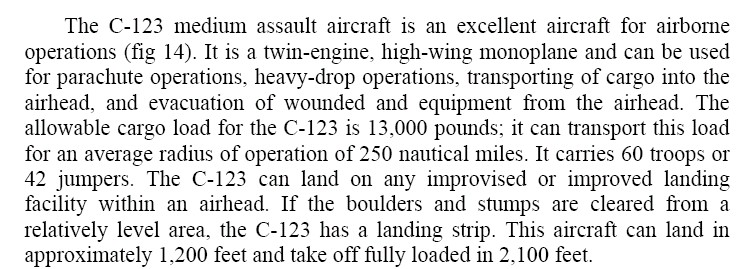
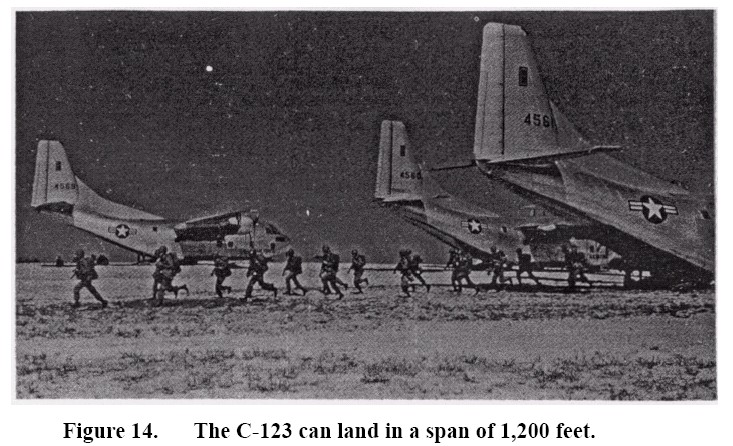
The t-tail, rear ramp innovation is credited to Michael Stroukoff in the late 1940s whose CG-20 metal glider had piston engines and jet pods added to it to become a STOL airplane but only with a small 13, 000 pound cargo load.
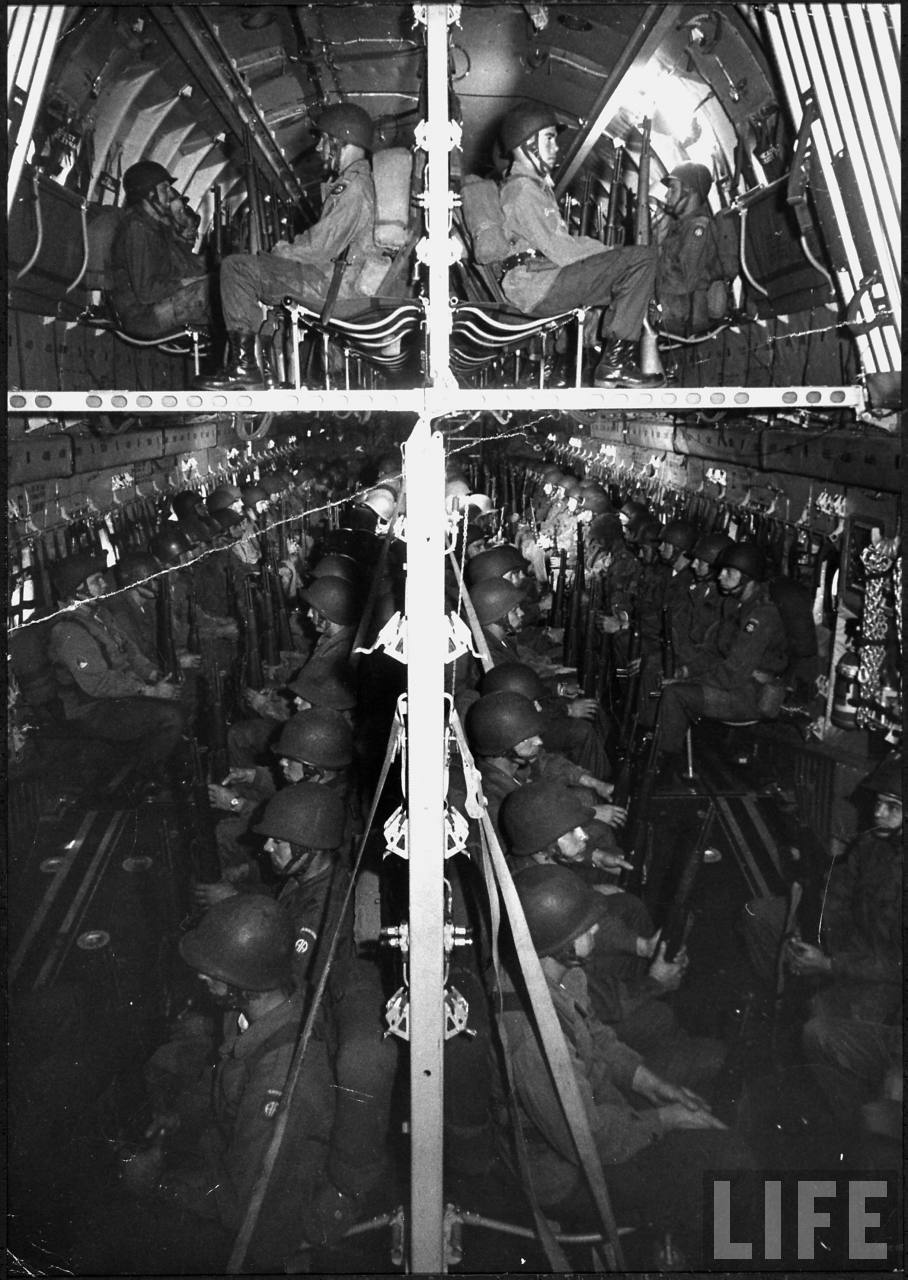
So while the C-124 could carry a bunch of (117) Paratroopers on its two decks, it couldn't drop them any light tanks--so Airborne planners would have to reverse-engineer around this equipment weakness and seize an airfield and a runway so C-124s could airland and roll-off M41 light tanks; a disaster waiting to happen as Maleme airfield on Crete in 1941 warns us.
You may ask what of the large turboprop C-133? Couldn't it paradrop M41s?
The answer appears to be YES, but the USAF only bought a small number of them. C-133s did airland some M41s in South Vietnam to help put down an uprising as reported by tank futurist, Ralph Zumbro in his book, Iron Cavalry.
Thus, if the Army heavy tankers present you a too-heavy M41 light tank, and the USAF presents you with no airplane to paradrop it, what do you do?
The fully enclosed Ontos was not good enough, but the exposed M56 Scorpion is?
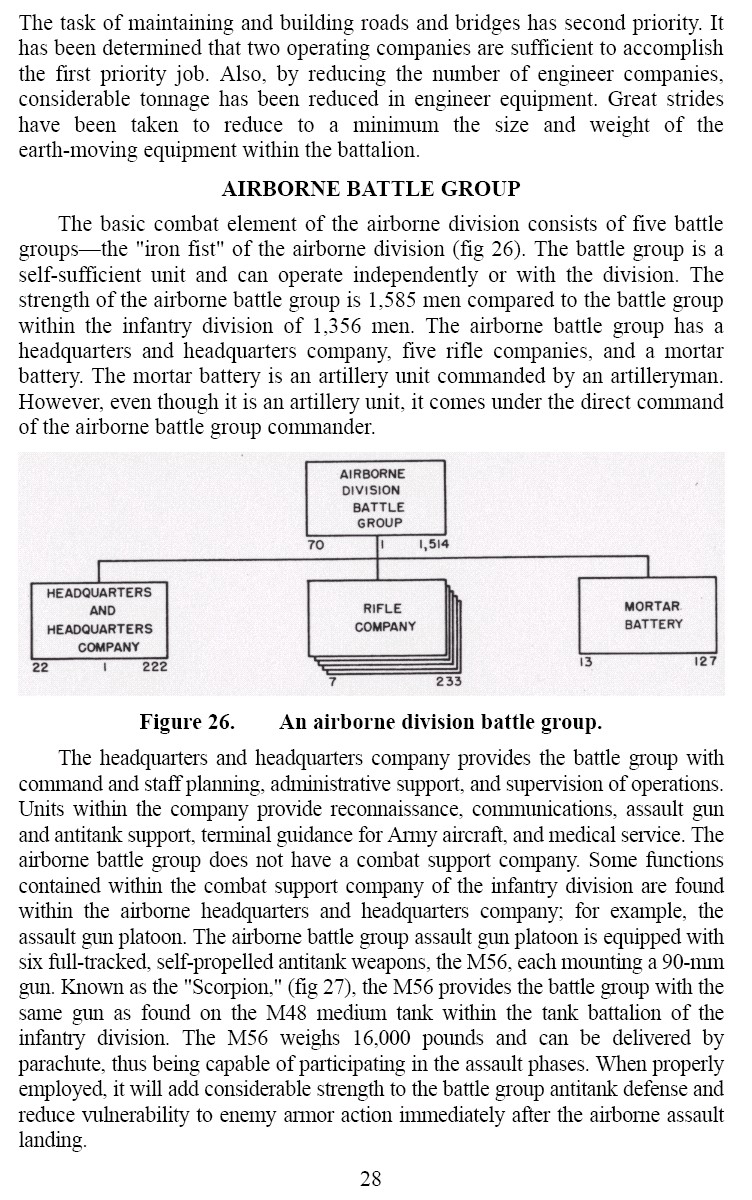
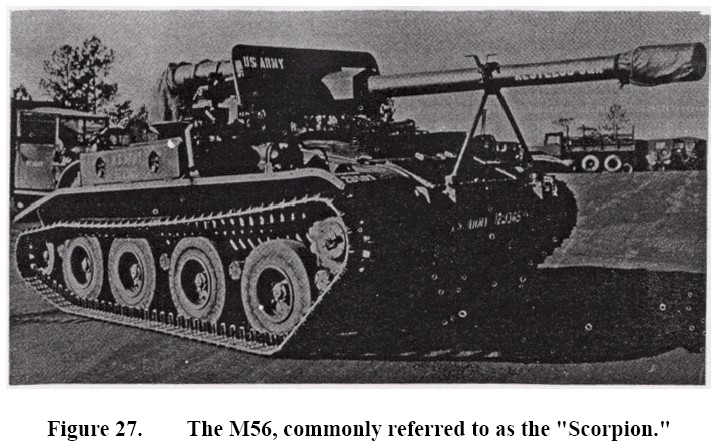
Enter the 8-ton M56 Scorpion; a strange rubber-tired, tracked tankette with the M48's 90mm gun on top on an exposed mounting with a gunshield powered by a gasoline engine. Why this was acceptable and the fully armor-enclosed Ontos was not--is a mystery. The Scorpion would see limited action in Vietnam and its exposed nature did create problems whereas the Ontos performed brilliantly and achieved legendary successes so the USMC had to retire them and not replace them lest their weak infantry egos suffer.
Solutions In-Bound; Army Airborne Botches Them
The advent of aluminum alloy armor in the 1950s for the first time made it possible for a fully-enclosed 9-man infantry squad carrier under 10 tons--compared to the 20+ ton steel monstrosities like the M44 and M59 neither of which could even fit into a C-130--much less be taken into the air.
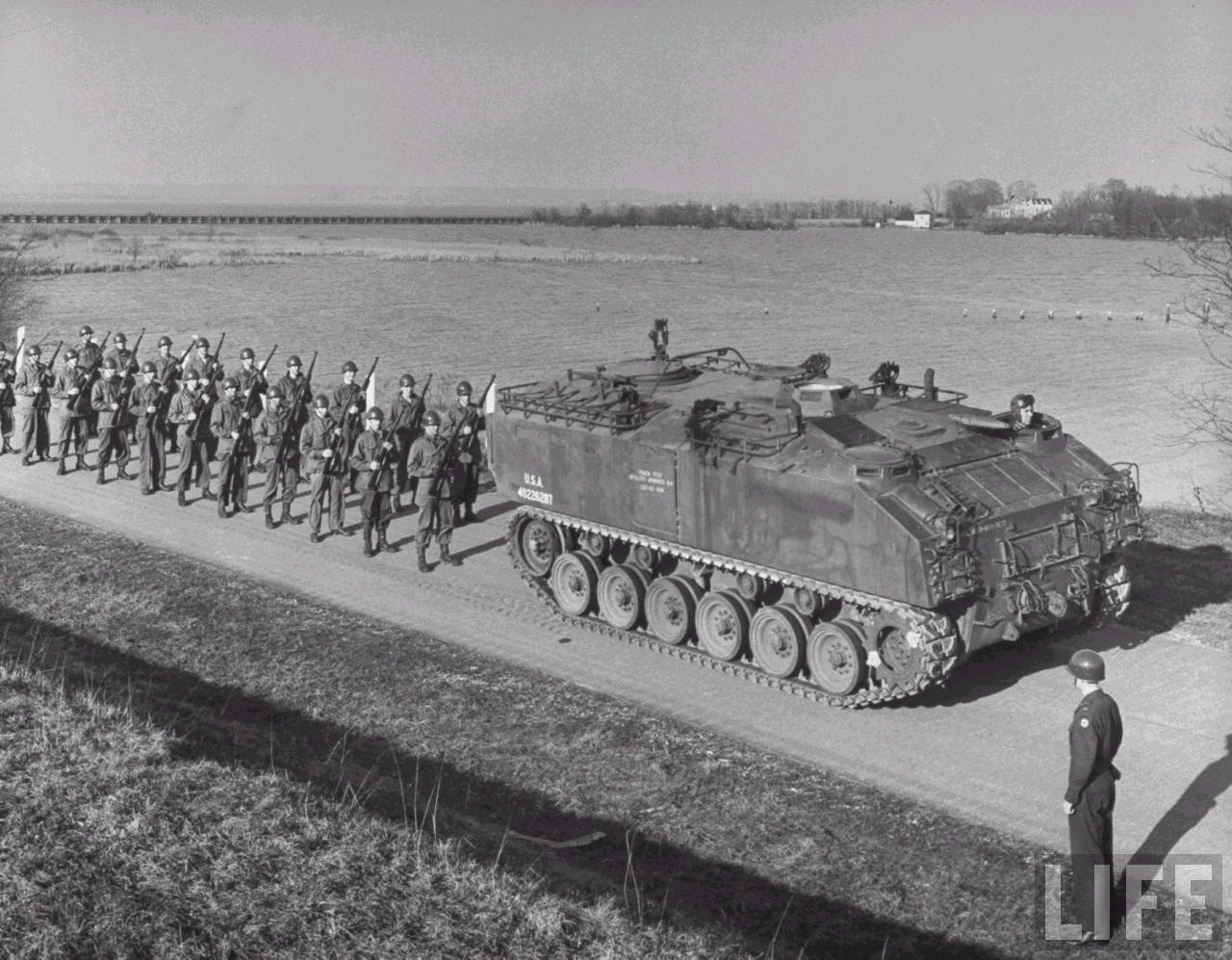
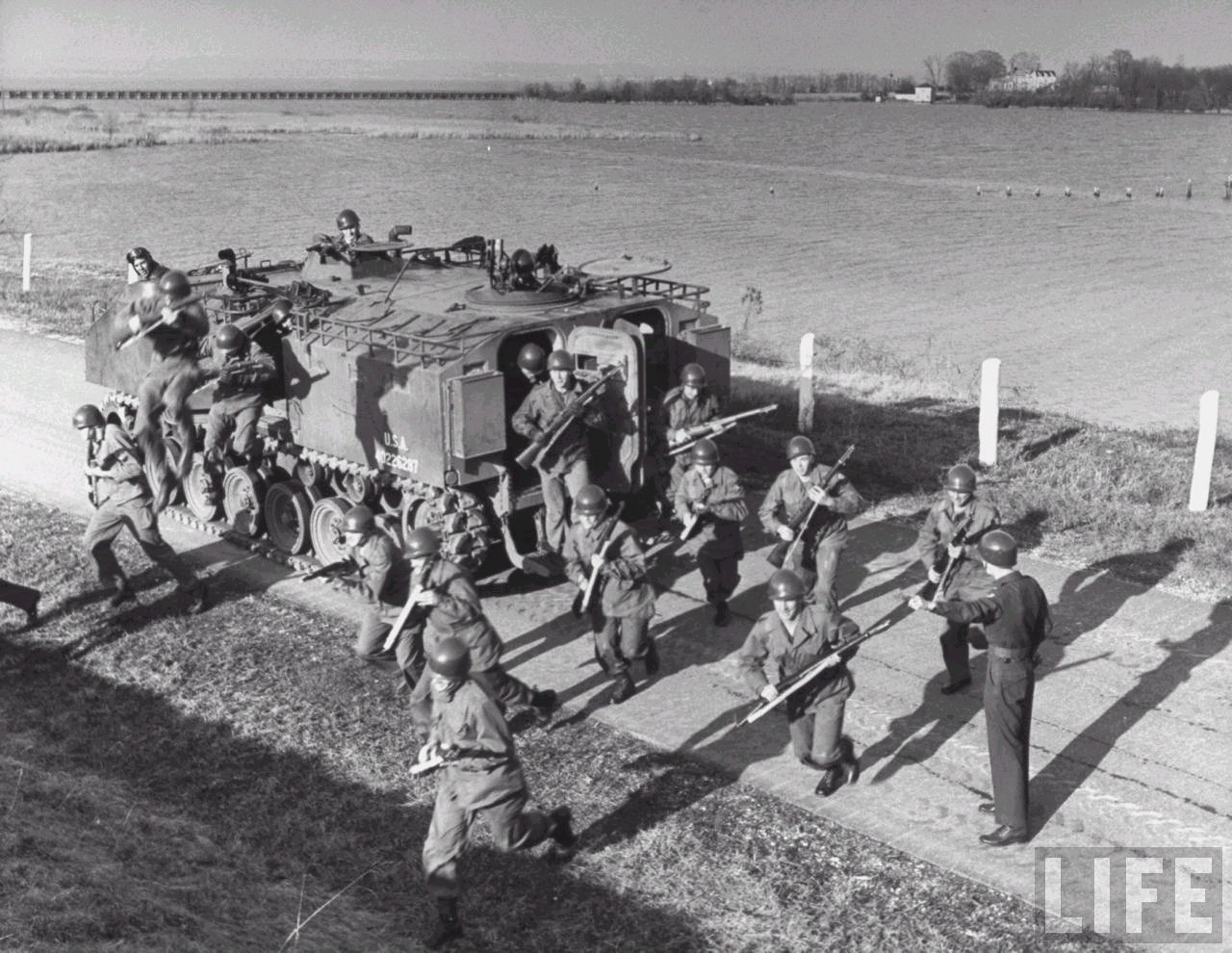
LTG Gavin's Pentomic Army Airborne had a transportation battalion of Airborne Armored Multi-Purpose Vehicle family (AA-MPVF) designed M113s that plentiful C-130s could fly to anywhere in the world and be paradropped to transport Paratroopers as needed over non-linear possibly nuclear devastated battlefields. Problem #1 solved.
To replace the M56 Scorpion was to be the Armored Reconnaissance Air Assault Vehicle (AR-AAV) that would not only be C-130 paradrop mobile, but would be heli-liftable by CH-47 Chinooks and CH-54 SkyCranes. The heavy tankers who made the M41 too heavy got involved and insisted that the AR/AAV have a TURRET and this made the weight increase to 17 tons which is what was fielded as the M551 Sheridan with 152mm missile/gun launcher in 1966. Problem #2 partially solved.
When LTG Gavin retired in 1958, the Airborne had an APC and a light tank both of which were C-130 airdrop-capable on the way. Then the light infantry narcissists botched nearly everything. First went the transportation battalion, making the Paras foot-slog exposed again. Next, they didn't demand a reduced-size M113 say bristling with 7.62mm Mini-Guns or 20mm autocannon that could fly by helicopters to accompany them in air assaults in Vietnam so they suffered heavy casualties in battles like LZ X-Ray in 1965. They were content to let their M551 Sheridans be owned and operated by parachute-qualified tankers whose own Armor branch disliked them almost as much as the rank & file Airborne infantry did. So the Airborne in Vietnam flew into battle by helicopters and on occasion by parachute only to become stranded to foot-slog within short-range 105mm artillery firebases content to get armored shock action later from M113 ACAVs and M551 Sheridans light or M48 Patton medium tanks from units like the 11th Armored Cavalry Regiment. With the Airborne not taking responsibility for its own armored mobility and fire support and instead dumping it onto hostile heavy tankers--its no surprise that when the M551 Sheridan was retired that its replacement, the M8 Buford AGS was not purchased by the heavy-tanker controlled HQDA.
Its High Time the Army Airborne Takes Responsibility for its own Armored Mobility and Fire Support
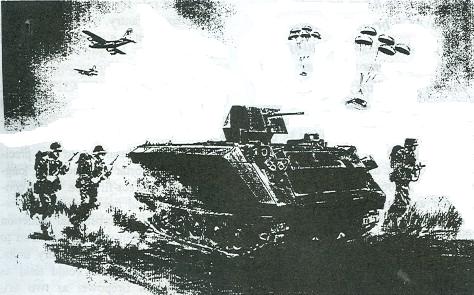
Enough is enough. Its high time the Army Airborne realize that 1.) it is a functional CAVALRY that does 3D maneuver; 2.) the non-linear battlefield dominated by high explosives demands that it be light tracked, air-mechanized 3.) that the responsibility for providing armored personnel carriers and fire support tanks rests with them not others who they can disparage while they provide a vital service.
The way to achieve this is by creating a tracked, armored transportation capability in every light infantry battalion by re-equipping Delta Weapons companies with High Technology, stealthy electric drive and band-tracked, up-armored M113 Gavins. The Delta weapons company's heavy machine guns, grenade launchers and TOW anti-tank guided missiles will be more aggressively employed against the enemy from armored mounts capable of unpredictable cross-country maneuver than road and trail-bound Humvee trucks. Future M113 variants can be reduced in size to fit inside CH-47 Chinook helicopters to render air assault armored mobility and shock action we have needed for decades.
AIRBORNE ARMOR 1930-1959 before the Wiesel...BV-206....the BMD...and the M113...
Today after over 4, 500 dead, 24,000 wounded--some of them maimed for life from Iraq, the objective adult has to ask the question why are 4 of the U.S. Army's Divisions still driving around in thin-skinned HMMWV trucks when they could have had light tracked armored fighting vehicles (TAFVs) all along? Why does its iother 6 heavy divisions drive around in thin wheeled vehicles? There is no "front" lines and safe "rear" areas on today's non-linear battlefield. One of the U.S. Army Airborne's founders, General James M. Gavin realized this years ago and even went so far as to design a light TAFV armored personnel carrier, the Airborne Armored/Multi-Purpose Vehicle Family which became the legendary M113 Gavin, and the AR/AAV, which became the awesome M551 Sheridan light tank. What is the mental block here? Light TAFVs weigh roughly the same as a FMTV 5-ton cargo capacity truck (22,000 pounds) in use by U.S. Army Airborne/Air Assault/Light units, yet offer tremendous protection against RPGs, roadside bombs, and all sorts of small arms fire as the vehicles offer unsurpassed cross-country mobility to include swimming across lakes/rivers/oceans, none of which wheeled trucks can do. The needs of 3D maneuver warfare demand light TAFVs yet the corrupt, narcissistic, egomaniac culture of the U.S. Army is unable to grasp the realities of the non-linear battlefield to employ light TAFVs which fall in between the lightfighter egotists who think they don't need ANY armored vehicles at all and the too-heavy tank egotists who want to fight only in vehicles that are invincible. We need heavy TAFVs for open-terrain, 2D maneuver warfare not as a one-size-fits-all panacea. This distinction is not possible to the heavy tank or lightfighter egotist. This is what happens when you create an All Volunteer Force (AVF) of weak co-dependants to do your national defense instead of incorporating your entire citizenry to insure objective, mature adults are involved in the details of national defense.
Looking back at the1950s...
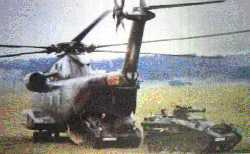 1980/90/2000s???
1980/90/2000s???
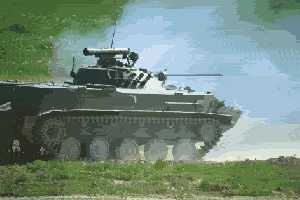 1970s???
1970s???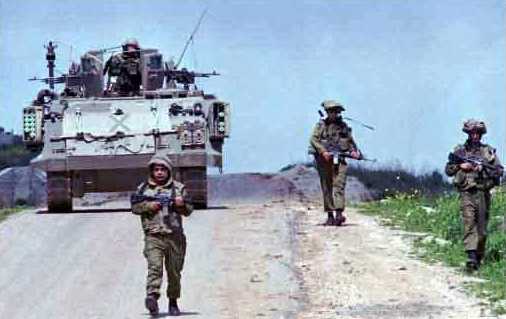 1960s???
1960s???
Why didn't we buy the French AMX-13 "off the shelf" for our Airborne in 1959????
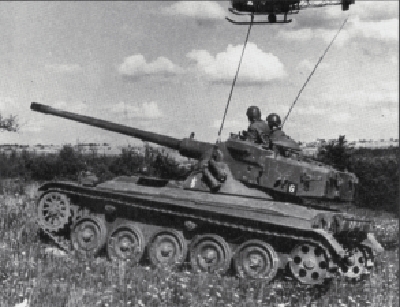
Above: This AMX-13 Light Tank sports a 105mm gun which can fire a HEAT projectile that can penetrate 14" of armour at an incidence of 0° and a range of 3280ft (1000m).
Country of origin: France
Crew: 3
Armament: One 90mm or 105mm gun; one 7.5mm or one 7.62mm machine-gun co-axial with the main armaent; two smoke dischargers.on each side of turret.
Armour: 0.4in-1.6in (10mm-40mm)
Weight: Combat 33,069lb (15,000kg)
Ground Pressure: 10.81 lb/in sq (0.76kg/cm sq)
Engine: SOFAM Model 8 GXb eight-cylinder water-cooled petrol engine developing 250hp at 3,200rpm.
Performance: Road speed 37mph (60km/h); range 218 miles (350km); verticle obstacle 2ft 2in (0.65m); trench 5 ft 3in (1.6m); gradient 60%
The AMX-13 now has a 105mm gun and is STILL IN SERVICE!!!
Instead of buying the combat-proven AMX-13 (Suez canal with French Paratroops/Sinai with IDF Paratroops in 1956 war) we developed our own M56 Scorpion 90mm SP gun (an automotive dud like the M50 Ontos) and then the M551 Sheridan (1966) ten years too late. The Israelis had HUNDREDS OF AMX-13s in the 1950s, our Airborne had NONE. ZERO. NADA. What about the M113, why wasn't it used as an Airborne APC in conjunction with the M551?
Russians see the light, Americans are clueless
www.ipmsottawa.ca/topic.asp?TOPIC_ID=96&FORUM_ID=13&CAT_ID=3&Forum_Title=Armour+kit+reviews+%26+articles&Topic_Title=Eastern+Express+1%2F35+BTR%2DD+Airborne+Links+Vehicle
"In 1965, when the Soviets felt that their airborne forces would be cut to pieces if they landed in the rear of NATO troops with no support, legendary airborne General Margelov created his "centaur" - the BMD-1 or airborne infantry combat vehicle. Mounting a complete BMP-1 turret on a very lightweight hull, it created an 8 metric ton vehicle that could be airdropped, provide room under armor (albeit quite cramped) for six men, and provide airborne forces with overwhelming firepower against rear echelon forces."
Why didn't we put a powerful turret weapon on M113 Gavins and supply them to our Airborne forces, too? Not-Invented-Here-Syndrome (NIHS)? Our arrogance didn't stop us from emulating the larger BMP into the oversized Bradley Fighting Vehicle...(BFV). We invented the airdroppable APC, the M113 Gavin, remember?
Where are the Airborne Fire Support Light Tanks?
After sterling service in the '60s/70s/80s/90s the combat-proven (Vietnam, Panama, Desert Storm) M551 Sheridan the first Airborne light tank to be airdropped into battle--is now retired to NTC as an OPFOR "MILES wargame toy", the promised superb, shoot-on-the-move M8 Buford Armored Gun System (AGS) cancelled in a HQDA back-stab/lie ("We don't have the money" to buy the $3.5 million dollar light tanks but we do have the money to waste $100 million on a paper study "tank", ehh "Future Combat System" to replace our 70-ton "land mastadon" M1 Abrams heavy defensive tanks 20 years from now, after dozens will have died needlessly without fire support). We could have bought the M8 AGS "off-the-shelf" like the AMX-13 decades ago, but that would have given our fighting men battle-winning/life-saving capabilities, and WE CAN'T HAVE THAT! "Buy American" has ended up meaning BURY AMERICANS. Armor branch is too eager/busy to duel other tanks to fire support for the infantry or obtain operational decisive 3D maneuver by AIRDROP--"egggadss! Jump from an airplane? Take personal risks to life/limb to get this? No, we'll wait for the airhead is secured and we will AIRLAND (even better would be slow sealift so the 'fly boys' can pummel the enemy for weeks and we can have plenty of time to 'get our act together' and have numerical superiority), so we can fight comfortable, no-risk-to-careers war, sitting down with all our 'toys' (Battlefield Operating Systems) in play so we never have to struggle." The American consumer-mentality style of warfare? And we wonder why DoD favors USAF airstrike bombardment?
And what about the AMX-13??
Why, its still in service around the world...
And the U.S. Airborne...why, it still has no light tank...after 6 decades from WWII...?????
...and still no Airborne APC?
Do I detect a foul odor emanating from those wearing shiny metal? The Russians have integrated Armored Fighting Vehicles from the very beginning of parachute forces in the 1930s!!! Every other Airborne force in the world has seemed to "hack" getting light AFVs into their force structure except the U.S. Army's Airborne, WHY IS THAT?
Where were the U.S. Army's Airborne leaders during the last 4 decades? Were their "heads in the sand" or drunk at the O-club moaning about Airborne fatalism singing "Blood on the risers"? We have had 10.5-ton M113 Gavin light troop-carrying tanks in use for over 4 DECADES, and no one in the U.S. Army Airborne bothered to think of obtaining some so we could have AIRBORNEmechanized warfare capabilities like the Russians achieved in the 1950s with first the ASU-57, then the ASU-85 and then the BMD family!??
EXCLUSIVE! See video clip of Russian Paratroopers jump followed by ASU-57 Assault Guns:
www.combatreform.org/russianairbornejumpwithasu57tafv.wmv
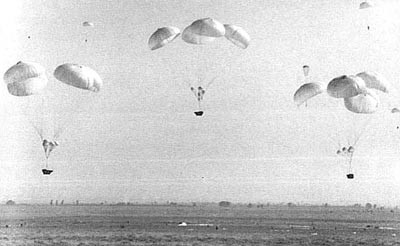
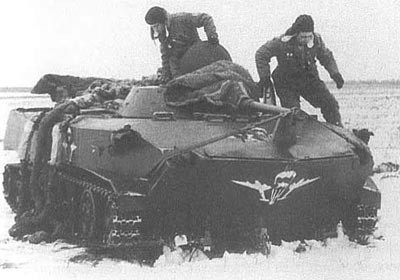
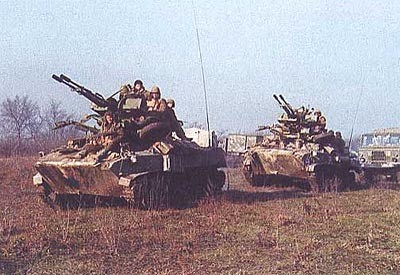
Hmmm...let me see....M113A3, 11 tons = 22,000 pounds. There is an official U.S. Army airdrop rigging manual for the M113 APC.... The C-130 can carry 42,000 pounds. Hmmmm...42,000 minus 22,000 equals 20,000 for fuel, airdrop supplies/platform, and a full squad of Airborne infantry to operate the M113A3 Gavin once its on the ground....HELLO? We even now have Wiesel II 3-ton and BV-206S armored SUSV light tanks which can be carried inside helicopters for AirAssaultMECHANIZED warfare capabilities. Or are "Airborne" and "Air Assault" wings just snobby badges to look down on others and not about 3D warfighting? Maybe we ought to list "INNOVATION and EXCELLENCE" as U.S. Army core values instead of saying be submissive/defeated by saying the same thing 3 times with respect, integrity, honor (which mean the same thing) and maybe, just maybe...we will not be caught in the next century with our forces unready for the NEXT PATTERN OF WAR our unpredictable enemies will throw our way. Other than this, our Airborne warfare innovations of late could be summed up in one word:
BULLSHIT.
Its HQDA "heavy tank destroyer mafia" crap not wanting Airborne/light forces to have operational maneuver/independance...because we might put their land mastadon units out of business, whch they wouldn't but they can't take any chances...ALL BECAUSE THE U.S. ARMY DOES NOT HAVE A CAVALRY BRANCH TO INSURE MOBILE WARFARE, THE LIGHT TANKS, AIRCRAFT AND PERSONNEL EXIST to prevent platform-centric minds turning tanks and aircraft into a mini-version of a bloated bureaucratic "cash cow". Its "light-itis" from people who want to walk wherever they go with a heavy rucksack on their back so they can look down on others and call them "legs" as if "Airborne" is an excuse to be a snob and not a way/means to win wars. The American Airborne has paid for an air-droppable light tank and troop-carrying version in BLOOD and shouldn't let some young punks give their sacrifice a bad name by ignorant snobbery and closed-mindedness.
VIETNAM: WHERE WERE THE LIGHT TANKS TO USE WITH HELICOPTER AIR ASSAULTS?
NEW REVELATIONS!
We had the M56 Scorpion with open-topped 90mm gun that was used by the 82nd Airborne in Vietnam....why weren't these light TAFVs supplied to the Army's Air Assault units who desperately needed their firepower and hitch-a-ride-on-back tracked mobility as they fought the NVA "even" M16 versus AK47?
Why wasn't the Ontos or Scorpion, M114s or M113 Gavins used in conjunction with CH-47Cs for Air Assault 3D operations??? We ask that question in our AMS book. The Cavalry to its credit did emply M113 Gavins, M551 Sheridans as the 2D maneuver axis working in conjunction with light infantry delivered by helicopters as the 3D axis to great effect. But why not combine the two for a 3D element that on the ground has greater mobility and firepower?
My theory is that Gen Kinnard was too much of a light infantry-only type and he didn't push for it as Col Moore did with the AR/AAV which became the M551 Sheridan which is way too heavy for Chinook lifting, but I've seen it lifted by a CH-54 Skycrane so go figure...???
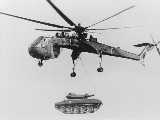
I think lightfighter ego was in effect even as far back as the open-minded '60s.
Andy MacDougall asks why not the M50A1 ONTOS? (The Thing or the Pig)
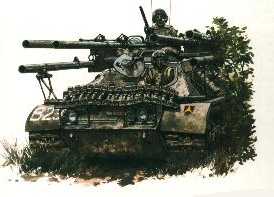
I have become infatuated with the Ontos lately, it seems like the M113's little tank-esque cousin. Speaking purely in terms of revisionist history, I have been fantasizing about how it could better have been used in RVN. Now the Army was dumb enough not to buy it but if they did receive them I would have had them organized into 10-Ontos platoons in every airmobile infantry battalion. These would then normally be farmed out 3 per company and be part of the initial LZ force with either one each underslung a Chinook or (since the Ontos is only 9 tons!) 2 per CH-53 along with the light infantry. Then when braking out of the LZ they would pull back at first to reload and then advance 2 at the front and 1 in "reload reserve". The platoon would also have 3x M113s with just a 2-man crew that would be ammo tracks and a place for the Ontos crew to 'hang their rucks', so to speak. Accuracy on the move would not be to much of a problem as main load would be either 4/2 or 6/0 APERS/HE shots. I would like to see a few mods:
1. A gun-port/vision-block in one of the rear doors for the "loader" to be above to defend the Ontos' vulnerable rear, he can also make sure no supported infantry have ventured into the backblast safety zone. TOE was usually to provide each Ontos crew with a Tommy Gun and this would due for the rear-defense role.
2. Stabilized gun. This may be to much to ask for this little critter in that day but it would be nice to be able to fire accurately on the move. 3. More fuel for longer range. THERE HAS GOT TO BE A WAY.
4. Forward gun shield for TC's MG.
5. 3x periscopes for both driver and TC, they apparently only have 1 witch is really absurd, WAY to narrow vision, on the Ontos concealment, observation and movement are key to survival, only 1 periscope greatly hinders this.
6. Greater traverse and elevation, but this doesn't seem possible to fix without so much modification it would be a totally new vehicle.
7. Stand-off armor to ward off RPGs/RRs. Be it ball-n-chain, cardboard boxes or chickenwire, whatever works, gotta improve survivability.
8. Since there is a instruction panel behind the TC's seat on how to use the weapons systems, why not one in the driver's compartment on how to drive it and on the inside of the main engine compartment access door on basic maintenance? Then it's virtually a self-propelled Panzerfaust!
http://afvinteriors.hobbyvista.com/ontos/ontos1.html
Now many would object to the Ontos because of it's thin 1/2" steel armor, and my reply would be that it is made to be, and vary much considered, HIGHLY EXPENDABLE, again much like the Panzerfaust. Cleaning out the interior of human remains and finding a replacement crew (all they have to do is read the instruction panels to operate it! ha ha, dumb-ass beast the Ontos is!) is the cost of doing business. That, I as the commander, think it better to sacrifice the Ontos' crew, and maybe the vehicle its self, in return for increasing the survivability of the rest of my unit by having overwhelming direct fire support available the moment the airmobile infantry touch down, thus I save on men and materiale the on balance. REMEMBER FOLKS! War is the art of destruction, we can't not field something because we feel it could "get a boo-boo", without something like the Ontos on the LZ, those poor SOBs who it aught to accompany are going to get a HELLAVA LOT MORE BOO-BOOS. The Ontos has just as much armor and firepower as the Sheridan only half it's weight and size. The Ontos is an expendable beast of burden designed for winning, like the infantry is should accompany, this may not be pretty but it's the facts of War, so deal with it.
"Ontos: Airborne tank for the 1960's!" ;-)
MORE ON THE ONTOS
Adapted from Michael Scudder's web page http://ontos.homestead.com/ms3.html
ONTOS (M50A1)
Ontos means "the thing" in Greek. As applied to the Marine's armoured vehicle, it could mean "the rare thing". This armoured vehicle made significant contributions to the success of marine and Army infantry operations in Vietnam, but less is known about the vehicle than any other armoured vehicle produced by the U.S. military. Even among military vehicle collectors, the name Ontos often draws blank expressions.
The reasons may stem from the fact that the Ontos was produced in small numbers. Only 176 vehicles are known to have been in the marine corps at the start of the Vietnam War. Another factor is the marine corps quickly disposed of the surplus vehicles; removing much of the hulls and gun mounts. With so few examples of surviving Ontos making it into the hands of museums and collectors, its story didn't get told. There are more surviving WWI tanks today than Ontos.
OVERVIEW
The Ontos was a relatively light weight tracked armoured fighting vehicle that was designed in the early 1950's to destroy the main battle tanks of this era using the firepower from its six 106mm recoilless rifles. Its diminutive size, 12 1/2' long, 8 1/2 ' wide, crammed three crewmembers into a compartment slightly higher than 4'. It served the U.S. marines from 1956 until the bulk of them were dismembered in 1970. Its service to the marine coincided with the Corps's use of the M40 106mm recoilless rife.
The Ontos would be more than 10 years into its life cycle before it would be tested under fire. The first test would be against the Dominican rebels in April of 1965. The second test was in the environment of Vietnam; and its role would have no relationship to what was originally intended for this fast little tank killer.
If it is true that an army fights its present war with tactics and equipment from its last war; then it is the mark of a successful army to be able to adapt in order to accomplish the new mission. The Ontos and its crews had to convince the marine corps leadership that this fighting vehicle had a role in Vietnam. The success, at convincing its leaders of the Ontos's potential, is mixed. The men that made up the Ontos crews attest that it was only at the company level that they convinced leadership of the enormous firepower that could be available to the grunts; firepower that could change the outcome of a fire fight.
I am struck at the similarities of the Ontos's role within the Infantry Company and the role of the little Stuart tank used by the marines in the pacific battles of WWII. Both were lightly armoured and vulnerable to the destruction by weapons above 50-caliber. Both of these vehicles were effective because they were small yet could carry relatively high firepower into an infantry fire fight. Their size allowed them to go into areas the larger tanks could not.
The 20" wide tracks of the 9-ton Ontos would allow it to go on the soft soils surrounding the rice paddies of Vietnam. They both served as bunker busters. Both vehicles lessened the infantry's causalities by being close to the fight; and could be quickly deployed to overcome an enemy's fixed positions.
The Ontos carried the beehive round that sent out a hundred darts per firing to clean out a jungle of its enemy. There was no other weapon that could clear a jungle for a depth of a 1/4 mile like the 106mm recoilless rifle using the beehive round. In contrast, Artillery shells and bombs effectiveness were limited to the area of a direct hit.
The jungle vegetation absorbed both concussion and fragmentation. Other vehicles that mounted the 106mm recoilless rifle like wheeled jeeps and M274 MULE ATVs were open to enemy small arms fire. The Ontos could expose itself to enemy small arms for the short time it took to empty its 6 guns and depart to a more secure position to reload. It was an armoured shotgun and the North Vietnamese Army feared it. The same was found true for M113 Gavins with 106mm RRs.
It is no surprise to the veteran of any country's army that weapon systems get misused, unsupplied and/or forgotten by the generals that demanded their development. The Ontos fell into this grouping. Deployment of the Ontos seemed like an after thought to many commanders and the Ontos's parts replacement was a serious concern. It is a testament to the men that manned this small armoured fighting vehicle that some important history was written by its participation in Vietnam.
The Ontos was designed in another era for another purpose. Developed to kill tanks; the Ontos had no chance to kill any tanks before it was in the hands of its first crewmen. It was left to the men who manned the Ontos to reinvent it for the task at hand in Vietnam; and they reinvented it into a weapon that served the marine/army infantryman who had to kill enemy infantrymen hiding in difficult jungle terrain and in fortified bunkers/trenches.
The Ontos crews were pulled from the marine infantry nattalions to learn the trades of gunners, radiomen, mechanics and tacticians. The marine designations for jobs within the infantry battalion were in the infantry MOS series of 0300. The Ontos's crews carried variations on these job numbers. Some crewmen were motor transport or track maintenance trained, but most were more likely to be former 0311 riflemen. After their tours with the anti-tank units, they were just as likely to return into the battalions from which they came as to be reassigned another anti-tank unit using 106mm recoilless rifles on jeeps/M274 MULEs.
The marine high command was single minded in pitting the marine infantryman against the North Vietnamese Army and Viet Cong veterans and took the heavy casualties to prove it. They felt, with good assurance, that the individual marine, coupled with traditional artillery and air cover, could defeat this enemy without any distractions from those weapons not carried to the field by their enemy. They were wrong of course, and as the enemy had superior mobility and firepower on foot against marines, something had to be done to even the fight.
Almost everyone in the early days of the war believed that Vietnam was "not conducive for tank operations". They reasoned, if it were, the NVA would have fielded armour. As a matter of fact, the NVA disd field tanks and eventually stormed South Vietnam in Russian tanks to end the war. Since tanks were not fielded by the NVA in the early days of the war, then there was little use for the small anti-tank TAFV known as the Ontos, but also known as a "pig".
The marines carried its' M48A2 medium tanks and Ontos into the fields of battle by accident when they landed in DaNang in 1965, but they didn't command the focus of the Regimental and Battalion Commanders as did the traditional attachments such as the 81mm and (107mm) 4.2 mortars, 105mm artillery and close air support. The Ontos's deployment was often a knee-jerk decision by Battalion Commanders. They were used mostly as perimeter defence with some convoy escort duty.
Vietnam was primarily run by our civilian politicians; with rules of engagement (ROE) that totally handicapped the military commander. Our air power was forbidden to knock out the surface-to-air missile (SAM) sites that depleted our ranks of aircraft and pilots. In early Vietnam, the enemy could retreat to areas forbidden to U.S. forces. These rules as applied to the Ontos crews decreed that all major calibre weapons had to secure "Battalion authority" before being loaded or fired. The early Ontos crews were expected to go into combat areas unloaded. Later, they could have 106mm rounds in the guns, but had to secure authority by radio to fire.
These absurd rules would have given nightmares to leading WWII or Korean War veterans who would have said, "Fuck you. I'm doing what it takes to win". But Vietnam was the last hurrah for the 2d and 3rd string veterans of WWII/Korea and a lot of newbies without any war experience. They all wanted to get promoted and "not rock the boat". If the marine commanders ignored the attributes of the Ontos, the NVA didn't. In almost all my interviews with Ontos Crewmen, one point was brought up. The NVA was frightened of the Ontos and would avoid contact if possible. Most contact between NVA and the Ontos was inadvertent on the part of the enemy.
DEVELOPMENT
The Ontos project was awarded to the Allis-Chalmers' farm machinery Division of Wisconsin around the early part of November 1950. The Allis-Chalmers engineering section was comprised of about 50 to 60 engineers; 90% of which would eventually work on the development of the first prototypes. All the prototypes were constructed in the Agricultural Assembly Plant in LaPort, Indiana.
The project was first envisioned by the government to be an air-transportable tank destroyer capable of being lifted by the cargo aircraft of the 1950's. The contract was to be for 1000 vehicles to be delivered to the Army. In 1953, the Army would refuse to accept delivery of the Ontos. At this point the marines accepted delivery of about 300 vehicles.
The government Ordinance Command, represented by Chief Engineer Carl Holmyard, delivered only one page of specifications. The specifications demanded that the vehicle would be powered by the same GMC six cylinder gas engine that was standard for the 2 1/2 ton military trucks of the day and a front mounted Allison cross drive transmission that would carry power to the tracks. The remainder of the specifications restricted the outside dimensions and weight so as to be air-transportable. The project was classified "Confidential".
This is the lowest security classification for government work, but it still required that the prototypes be built in a walled off section of the Agricultural Division Assembly Area. The government would accept the prototypes for testing only after the machines had 50 hours of running time. This required the engineering section to come to the plant on weekends and drive the prototypes around the grounds of Allis-Chalmers.
The Ontos had two large arms that held the six M40 recoilless rifles. These arms were joined to a shallow turret. This entire assembly was cast in armoured steel. The early prototypes could swing the guns less than 15 degrees left and right. The production Ontos was modified to turn the guns 40 degrees left and right. The welding of the Armoured hull was a problem for Allis-Chalmers. It took the failures of several prototypes to develop the proper welding techniques.
The first prototype Ontos had a track system similar to that used on the self propelled artillery vehicle called the Scorpion. This track system was later changed. This first Ontos prototype is still in existence and in the hands of Mr. Fred Ropkey. The later and final track system and suspension was of a new design. Each track consisted of two sections of rubber; 48" long with steel drive teeth in the centre. Twenty-inch wide steel grousers held the rubber and the drive teeth together. It took 5 sections of track to make up a complete track. A well-motivated crew could accomplish a track section replacement in about 11/2 hours. One crewman told me that a crew made a track repair in 42 minutes.
The suspension system was designed so that no mechanisms intruded into the already small interior of the fighting compartment. The road wheels hung on torsion bushings that were attached to the sides of the hull. There was much development in the special rubber compounds for the bushings. The rubber bladder gas tank was mounted in the front of the vehicle directly behind the glacis plate. It was cast of rubber and contained a tube-shaped void through its centre to allow the left drive shaft to pass through the fuel tank on its way to the left drive sprocket.
Allis-Chalmers had developed a deep water fording provision for the Ontos that was not accepted by the marines. It consisted of a waterproof covering for the engine. The motor would stay dry while fording. The fording gear had to be carried and installed on the Ontos prior to fording.
One of the problems that had to be overcome by Allis-Chalmers involved the track alignment. The lower chassis was constructed as a weldment. The distortion involved in the welding process caused the suspension to become out-of-line; and so the track would be thrown. Machining the lower hull, where the track suspension parts bolted to the hull, finally solved the problem.
Allis-Chalmers also developed a personnel carrier based on the Ontos track design. The personnel carrier had one additional 48" track section. No photos are known to exist of the personnel carrier prototype.
Much of the engineering work was completed in 1950 during a two-week design marathon. The marine corps continued to test the vehicles for the next six years until the vehicle was accepted in late 1956. A review of the chief engineer's notes for 1957 through 1959 showed a continuing series of revisions.
These notes, of Chief Engineer Craig Cannon, referred to a major revision of the Ontos called the "1960 project". Some of the proposed revisions called for an aluminium amphibious hull and two 105mm recoilless rifles (designated as T237 guns) fitted with a cylinder similar to a revolver pistol. This change would have allowed multiple firings of the two guns without the need for a crew member to reload the guns from outside the vehicle. Another major revision would involve the replacement of the engine with a turbine engine.
The "1960 Project" was never accepted. One of the early tests involved the acceptance of the aiming system of the six gun turret. Part of the test included the firing of all six guns at once. The test vehicle was taken to the Aberdeen testing facility that had been built for the testing of the 106mm recoilless rifle. No one envisioned the effect of six of these weapons going off at once, least of all the people who designed the testing facility. The back blast from the firing knocked bricks out of a nearby building and knocked the rear windows out of several cars.
Allis-Chalmers was to later refurbish the Ontos: removing the 6 cylinder engines and replacing them with the 361 cubic inch Chrysler V8. The change over involved redesigning the armoured engine covers with additional venting. It is believed that, of the 300 delivered units, only 176 Ontos were refitted.
THE ONTOS ARMOURED HULL
The 51" wide glacis plate of the Ontos is 1" thick. The glacis plate forms the front of the hull and would protect the driver and transmission from ground level to 27" in height. The side plates that hold the track suspension parts and form the sides of the crew compartment are slightly heavier than 1/2" thick. The floor of the fighting compartment is 1/4" thick of non armoured steel. The majority of the remainder of the hull is formed from 1/2 thick armour. The front engine covers are cast of armoured steel and its louvers have a 3/8' bead formed on the inside lip of each louver to defeat the entry of small arms fire from entering the engine compartment.
It has been speculated that the Ontos was top heavy and tended to overturn easily. I found that with the top hull, gun mount and guns removed, the vehicle still weighed in at more than 11,000 pounds. This 11,000 pounds would be contained within the height of the tracks (34"). I therefore doubt that the Ontos was seriously top heavy. Crewmembers have told me that the vehicle would slip sideways if traversing a steep hill before it would roll over.
The 106MM Recoilless Rifle Firing System
The Ontos had the ability to fire its 106 recoilless rifles one at a time or as many as all six guns at once. Four of the six guns had .50 caliber (12.7mm) spotting rifles attached. The flight of the .50 calibre spotting round approximated the flight of the 106mm round. This round was constructed as a tracer with a smoke puff that appeared on impact. The firing of the weapons was directed by the gunner; who had a seat to the rear of the driver and engine.
The gunner would often first fire the spotting round at the desired target and watch its flight. Often, even prior to the spotting round hitting the target, the 106mm round would be sent on its way. The maximum effective range for the 106mm round was 3,000 yards. The M40 106mm rifle was generally considered a direct-fire weapon, but the crews were taught, and used, indirect fire at targets not within sight of the gunner.
The 106mm recoilless rife is more than 11' long and weighs about 288 pounds each. The turret of the Ontos had to carry this 1,700 plus pounds over uneven ground. The strain on the gun mount required the crews to realign the guns from time to time. Two of the six rifles were designed to be easily removed from the vehicle and used with a ground mount should it be required.
THE ONTOS ORGANIZATION
There were three men to an Ontos: driver, commander/gunner and loader. If the Ontos was carrying a lot of ammunition and/or other gear, or if the weather was extremely hot, you could find the loader sitting on the driver's hatch, riding on the machine gun crossbar or riding in the platoon's 3/4 ton Dodge truck that often escorted a platoon movement.
The Ontos could and did drive with the rear doors open on occasions. This mode of travel would roll road dust into the interior making the crew look like pigs. For this reason the crews usually referred to the Ontos as a "pig".
The training of the crew varied as the demands of the war changed. The early crews, prior to March 1965, were trained at Camp Horno in the home of the 1st marine division, Camp Pendelton on the coast of California near Los Angeles. The training of later crews were assigned to units that trained them in the field. They had to learn: vehicle maintenance, small arms, tactics and direct and indirect fire.
All marines were trained in small arms, but the Ontos crews also carried a sub-machine gun that was not used by most marine units. They also had to know how to operate the three main radios and intercom. Some of the Vietnam assigned crews went to the firing ranges on Okinawa for extensive day and night-time firing of the 106mm rifles.
The Ontos crews were required to replace the 48" long sections that made up the track. They also tightened the track adjustment when a track was repaired or when a series of hard turns stretched it. An Ontos mechanic was assigned to each platoon, but the crewmen had to assist to keep the machines running. The platoons were often separated when assigned to infantry units.
The platoon mechanic was often unavailable to make a repair when needed. Replacement parts were often rare or non-existent. Many Ontos were turned into parts vehicles due to poor parts supply.
The Ontos platoons were organized into heavy and light sections. There were three Ontos in a heavy section and two Ontos in a light section. There were three platoons to a company; and three Companies to an Ontos Battalion. The 1st and 3rd Ontos Battalions saw action in Vietnam. The machines were in Vietnam from early 1965 to mid 1969. There is some evidence that at the end of 1965 there were 65 Ontos in Vietnam.
If this figure is correct it may have represented 45 Ontos of the 3rd marine Anti-Tanks and a lesser number from the 1st marine Anti-Tanks; as some of the machines were aboard ships in a standby mode awaiting to be deployed in any hot spots that arose.
The Ontos crew carried 6 of the 106mm rounds in their guns. They carried 8 shells in the rear storage area under the rear doors and 4 rounds in a rack located in the right rear of the vehicle. The loader would dismount and reload from this ammo locker. The interior of the vehicle may carry additional shells depending on the situation. I interviewed an Ontos platoon Sgt. that removed both the driver's seat and commander's seat and piled 30 additional shells into the cramped space. He sat on the ammo while driving or firing the weapons.
The crew also carried an M-3A1 .45 caliber submachine gun (also known as the grease gun or SMG) and Colt .45 automatic pistol (worn in a shoulder holster) with 250 rounds, 1,000 tracer rounds for the .50 caliber M8 spotting rifles, and 1,000 or more rounds for the 1919A4 Browning .30 caliber (7.62mm) medium machine gun. Many of the crewmen carried personal weapons.
Some of the personal weapons included shotguns and captured weapons such as the Thompson .45 caliber submachine gun, AK-47 and SKS 7.62mm x 39mm communist made rifles as well as the French-made submachine guns. One crew, known to me, also mounted a 60mm mortar on the front plates of the Ontos.
The marine Infantry Battalions were armed with the M60 7.62mm medium machine gun during this period. For some unknown reason, the Ontos continued to carry the older, light Browning .30 caliber M1919A4 medium machine gun. Some of the crews had the option of changing to the more modern, fully automatic weapon, but opted for the Browning. The older Browning had a reputation to require fewer barrel changes from heavy use. The Browning machine gun was mounted on a pipe support attached to the gun mount/turret. It could be fired manually or remotely from inside the Ontos by way of a foot pedal.
What happened to the Ontos?
The marines deactivated the Ontos from Vietnam in May 1969. A few of the Ontos were left in Vietnam and turned over to an U.S. Army Light Infantry Brigade near Tam KY. The Army ran them until they ran out of replacement parts. They then made them into fixed bunkers. The remainder of the machines in Vietnam were loaded into ships in May of 1969 for return to the U.S. The crews were reassigned to various marine infantry battalions. It tragic that Ontos' were not available for the disastrous Koh Tang heliborne assault in 1975 which resulted in 26 dead and 10 marines abandoned on the island.
Once the machines were returned to the U.S., their top hulls were cut off and many of the chassis were sold for construction equipment or given to local governmental agencies for rescue work.
"A BRIDGE TOO FAR" OR AN ARMY NOT THINKING FAR ENOUGH AHEAD?
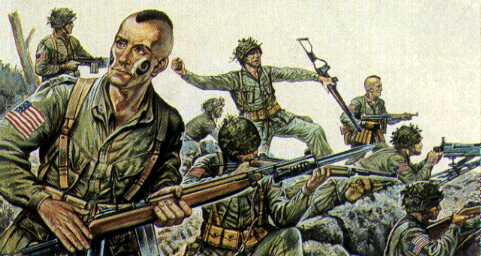
There are thousands of men DEAD who we left in the fields overseas who died because they were "A Bridge Too Far" for medium/heavy tanks to drive overland to reach them. The failure is ours for not supplying them with light tanks/APCs which they could have used to bust their way in minutes the 8 miles to the Arnhem bridge right from the Drop Zones--the entire British 1st Airborne Division holding both north and south ends, not just LTC John Frost's Battalion. Hold your seats!
Look carefully at XXX Corps traveling up the single lane highway in the film, "A Bridge too Far".....
See that open topped tracked infantry carrier the Brits are in?
That's a BREN GUN CARRIER, 4 tons. A mass-produced vehicle that could have been supplied en masse to our Airborne troops by large gliders. America mass-produced them as T16s. Again, no excuse.
REFERENCES ON BREN GUN CARRIERS:
Phil West's Carrier page
Excellent Bren Carrier Organization/use web page
War Gamer's Bren Carrier page
Bren Carrier Variants
UNIVERSAL (BREN GUN) CARRIER
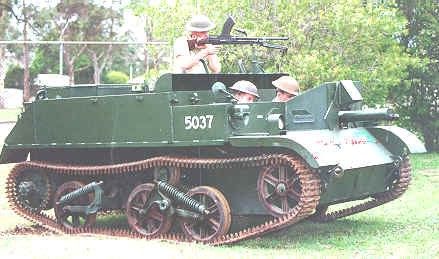
Bren gun carrier; fast, furious and lots of help
If light tracked Bren carriers were AOK to "patrolling and policing" captured urban areas in WWII then why and the @##$%% can't better protected M113 Gavins can't do the same thing TODAY IN IRAQ? What's the mental block?
Technical Details
Carden-Lloyd Series: Universal (Bren Gun) Carrier
Crew: Varied between 2-5 depending on the role of the vehicle.
Length: 3.75m, Width: 2.1Om, Height 1.6m
Power-plant: Ford V8 water-cooled petrol engine developing 85 bhp.
Armour: 12mm
Armament: Usually one Bren LMG .303 cal or a Boys .55 cal anti-tank rifle.
Performance: Speed 50 kph range 256 km. trench crossing 1.6m
Makers: Major UK automobile manufacturers, also made in great numbers in Australia, Canada, New Zealand and USA (where it was known as the T16)
Service History
The original role envisaged for the Universal Carrier was for a fast, lightly armed vehicle to carry infantry across ground denied by small-arms fire and specifically, the Bren light machine gun and its team, hence the name Bren Gun Carrier. (NB: A broad parallel can be drawn between that concept and the tactics of the APC (M113Al) Troop which carried an Infantry Company. Each infantry section, comprising ten men [one section to a vehicle] possessed a light machine gun crew of three men and a GPMG M60, cal. 7.62 mm).
There was only one version of this vehicle named the "Bren Gun Carrier" but whatever the task, the entire family of vehicles was known by its users as Bren Carriers. In fact, numerous copies of the original Bren Carrier were produced and these were commonly known as the Universal Carrier
The hull of these vehicles comprised a simple steel box with a motor compartment situated in the centre. In front, sat a driver and alongside him, a gunner. A radiator was mounted in a bulkhead between them, and the noise generated by the fan effectively drowned out any conversation between these crew members (NB: vehicles of this type were not fitted with any form of internal communications).
Behind the two crew, were two rectangular compartments, one each side of the engine, these were used to carry a variety of stores and/or personnel.
Loads varied, and it was common to find the Carrier employed in a number of roles e.g. carrying ammunition, infantry support weapons such as medium mortars (81 mm), Medium Machine Guns (usually the .303 cal Vickers machine gun). They were also used for towing anti-tank guns and trailers.
Because it was fully tracked, it proved to be a reasonably good, cross country vehicle and it was both agile and very fast, for its time. It was controlled by a small steering wheel and steering brakes.
Carriers were used extensively in every campaign during World War II. Such was their versatility, that many of those captured by the German Forces in France during the "Blitzkrieg" of 1940 were quickly put to use in patrolling and policing captured territory.
Australian Service History
Because of their general usefulness, Bren Gun Carriers were allocated to all types of Australian Army Units. Within the Armoured Corp, they were used by a number of units. For example, they were used in the Western Desert by 9th Cavalry and in Syria by the 6th Cavalry, as machine gun carriers.
Owing to the shortage of tanks, in the newly formed 1st Australian Armoured Division (1st July 1941), a great number of Carriers were pressed into service to provide tactical training for tank crews.
An example of its limitations in closed terrain are best summed-up in the following account: On 23rd November 1942, General Clowes at Milne Bay, New Guinea ordered a small number of Bren Gun Carriers to Cape Endaiadere as direct support to American troops operating in this area. It was made clear to the Americans that the Carriers were too lightly armoured and the crews too exposed for them to be used in isolation as tanks. In addition, they lacked any overhead protection from sniper fire, shell splinters and were extremely vulnerable to flank attacks. Thus they were forced to work with infantry support.
The aftermath of an attack at Cape Endaiadere on 5th December, resulted in vehicle crews being roughly handled and resulted in the abandonment of five vehicles. The supporting American infantry found they could not advance any further and the attack was called off. Sadly, it proved yet again, the futility of attempting to use inappropriate infantry carrier vehicles as gun assault tanks'.
At the end of the War, the remaining Carriers were relegated to a training role and numbers of vehicles were allocated to Reserve (CMF) Forces to make up the balance of equipment needed by newly formed tank units. Bren Gun Carriers were quickly phased out of service as more appropriate vehicles became available.
German service history
Original Designation: Bren Gun Carrier / Universal Carrier
Note: Bren Gun Carriers were converted to various roles such as:
Gep MG Trager Br 731(e) with Maxim MG08 gun
Original Role: light transporter
German Designation: Gepanzerter Machinengewehr Trager Bren 731(e)
Conversions/Role/Use: combat/reconnaissance/policing/training
Panzerjager Bren(e) with 37mm PaK 35/36 L/45 gun
Panzerjager Bren(e) with three 88mm Raketenpanzerbusche 43/54
Schneeschaufel auf Bren(e) - snow plow
2cm Flak38 auf Fahrgestell Bren(e) with 20mm Flak 38 gun
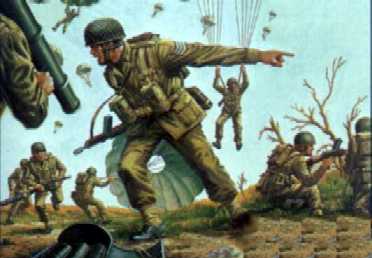
That's right.
Bren gun Carriers and Tetrarch light tanks (see article below)could have been carried in Hamilcar Gliders (2 Brens per glider) and/or airdropped or STOL airlanded by heavy transport bombers Soviet-style. Right after Normandy, the British 6th Airborne Division had light tanks glider-landed to them to stop German Panzer counter-attacks, why not at Arnhem?

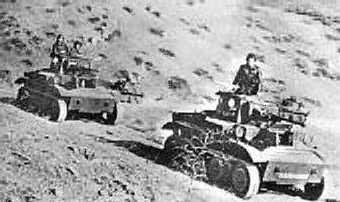
MYSTERY: WHY WEREN'T THESE LIGHT TANKS AND APCS USED AT ARNHEM TO CROSS THE 6-8 MILES FROM THE DZs TO THE BRIDGE?????
www.d-daytanks.org.uk/stories/gliders.html
Personal D-Day Stories - Gliders
Tank Museum photo No 4744/D/2 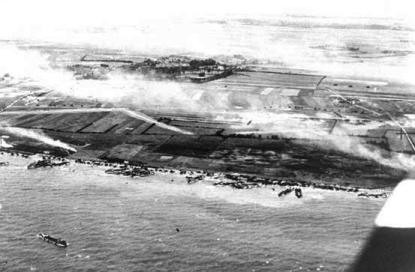
Crossing the coast of France, 1,500 feet up, and according to plan, it seemed too peaceful - rather like an exercise.
Casting off the air was crowded with other gliders, parachutes and discarded tow-ropes and we went down steeply on full flap, turning through 180 degrees. Without warning there came a tremendous jolting crash and the glider was partly stalled by colliding with another glider we hadn't seen, and we only had 600 feet to regain control.
Control was regained, just in time to round out but there was no time for anything else. We landed sideways, rushing through the tall French corn to a juddering halt.
My first pilot, Les, turned to me and said "time for a cup of char Tom!" we had two flasks strapped above our heads; one was still intact.
Staff-Sergeant Tom Pearce, Glider Pilot Regiment
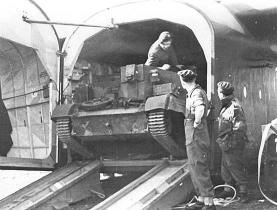
Tank Museum photo No. 1424/B/6
Before D-Day we were all penned in near Tarrant Rushton. The gliders were herring-boned in formation along the runway which we believed to be the longest in Britain at that time. Our tow planes, souped-up Halifaxes, came later.
"Approaching Landing Zone, ready for cast off" "Casting off!".
Then a gentle tug backwards, the nose dipped and turned and the wind whistled through the fuselage. The landing was a roaring, twisting, bumping skidding from high speed to a dead stop and we were all momentarily knocked out.
The side door opened and the pilot looked in "sorry for the rough landing boys" which woke me up. I unstrapped, dashed out of the door to let the undercarriage struts down only to find that it no longer existed and part of the wing was missing. The front was clear, vehicle engines running and all clear for exit except that the anchoring points were jammed. I took the escape hatchet from the wall, three or four good swipes, the [Bren] Carrier shot forward, the door opened and off they went.
Mr A Darlington. 6th AARR.
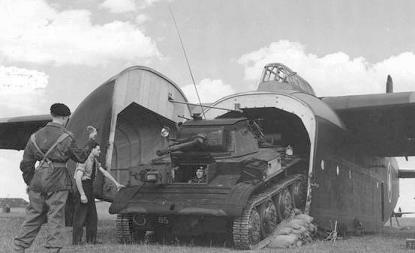
Tank Museum photo No. 1617/C/6
We took off next day, June 6th in the late afternoon, wondering what we were going to find over there. Most of us landed safely and on leaving the glider I hitched up the three trailers to my tank.
These contained petrol in the wheels and ammo in the large box between the wheels. We had very little opposition, a few mortars a distance away, when suddenly the tank stopped. The driver did not know why.
I slid out of the turret to the ground and found parachutes wound round the final drive. It was hard work cutting them off and, on moving forward we came across the Squadron Leader in the same boat.
We moved out in the morning, passing quite a few of our knocked out anti-tank guns. We took up position near a crossroads, a few miles from Ranville. Down one road, leading off from the crossroads, were German infantry in positions on the roadside. Our troop was detailed to do something about this so Sgt Knowles in the leading tank, Troop Leader and then myself in rear went like hell, machine-guns roaring..
But alas the driver in the leading tank got knocked out somehow, blocking the road. It was very narrow, so the Troop Leader and I reversed out round a corner, back to the crossroads. On inspection we had a bit of paint missing and bullet holes in the tool boxes. Once again we had been lucky.
Corporal Sheffield. 6th AARR
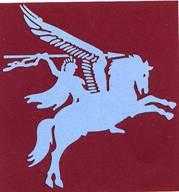
www.d-daytanks.org.uk/regiments/6th-airborne.html
Sixth Airborne Reconnaissance Regiment
In 1942 "C" Special Service Squadron of the Royal Armoured Corps, formed partly from men of the 10th Hussars, was attached to 1st Airborne Division, complete with its Tetrarch light tanks. Later it became known as 6th Airborne Reconnaissance Regiment in 6th Airborne Division and was based at Larkhill, on Salisbury Plain.
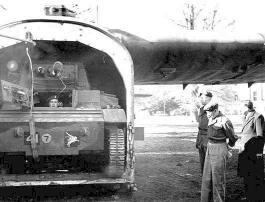
Tank Museum photo No. 4775/F/6
The expansion of airborne forces in Britain was due, to a great extent, to the success of German Paratroops during the invasion of Crete but, following the Allied landings in Sicily, in 1943 it was clear that troops would need immediate fire support when they landed, and it was believed that light tanks were the answer. The Airborne Division included Paratroops and infantry carried in gliders and it was by glider that the tanks would go to France.
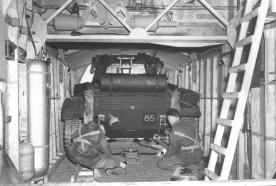
Tank Museum photo No. 0032/G/3
On D-Day the plan was to drop Airborne troops on both flanks with the British on the extreme left, east of the Orne river. Once the troops were landed, and the area relatively secure the big gliders, carrying the Light Tanks and [Bren] Universal Carriers, crossed the Channel. In practice the tanks were not very successful. Many got themselves tangled up in discarded parachute lines when they left their gliders and those that did go into action were no match for powerful German anti-tank guns.
[Editor: teach Paratroopers to collect their parachutes and bury them or stuff into their kit bags. Build BETTER LIGHT TANKS with guns/missiles superior to enemy tanks, gun positions, bunkers etc.]
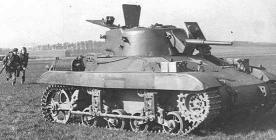
Tank Museum photo No. 3019/C/6
The regiment fought in Cromwell tanks for the rest of the war, except for the period of the Rhine Crossing in March 1945 when it was equipped with [M22] American Locust light tanks, once again in the Airborne role. Its last operational posting was to Palestine before amalgamation with 3rd Queen's Own Hussars.
Three museums cater for these Airborne units:-
The Tank Museum, Bovington.
Museum of Army Flying, Middle Wallop.
Airborne Forces Museum, Aldershot
THEN----the 1st British Airborne division riding in Bren gun carriers or on top of Tetrarch light tanks could have punched its way through to Arnhem or shifted quickly to the open southerly route LTC Frost's Battalion took.
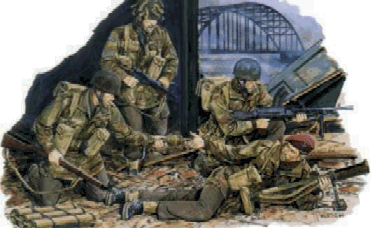
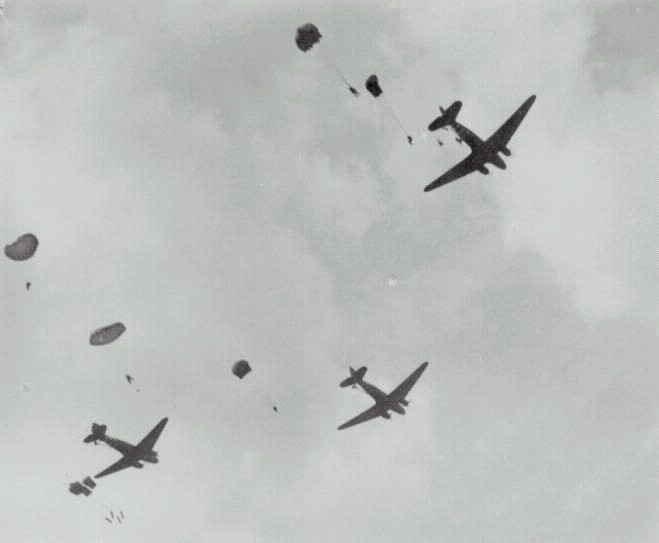
1. British 1st Airborne covers the 6-8 miles from DZs to Bridge in under 1 hour using air-delivered Bren Gun carriers and riding on light tanks Tetrarch/Locust, entire division takes BOTH SIDES of Bridge.
2. German Panzers counter-attack, are destroyed by recoilless rifles on Bren gun carriers, light tanks engage from flanks/rear, ENOUGH to hold. Small AFVs are nimble inside city streets.
3. Armored Bren gun carriers can foray into open Dropping Zones to collect supplies, the original purpose of the Bren, to advance quickly in the face of small-arms fire!!!
4. 1st British Airborne Division does not get annihilated like walking bullet sponges, because they can strongpoint several city blocks around the bridge over the Rhine. DEPTH = time and survivability.
5. Bridge held indefinitely as supplies dropped directly onto areas now controlled by British 1st Airborne Division
6. XXX Corps gets there whenever it gets there, crosses the Rhine and meets stalemate there.
AHA!
This is why after the German lines are breached we need to put Gen Patton in charge of Monty's Army Group for the killing blow to end the war sooner. But that's another issue entirely...
The point is....AIR-MECH-STRIKE could have took place in WWII!!!!!
We have been blind to this for decades!!!!
The Americans from the south rushing to their aid in BREN GUN Armored Personnel Carriers--Airborne MECHANIZED INFANTRY--lead by Airborne light tanks, not XXX Corps 50 miles away. Light AFVs could have been airdropped from the bomb-bays of our 4-engined heavy bombers way back in WWII had we thought of it. One of the Arnhem glider landing zones could have been used by special transport bombers to airland--WWII planes could land on grass---and deliver light AFVs, Soviet-style. Or light AFVs could have been delivered in gliders had we been more aggressive about it, today in 1999 on the verge of the 21st Century we have no excuse. We can airdrop anything we can carry. They paid for OUR MISTAKES with their lives and mangled bodies. They have earned the right to have the right equipment supplied to them from Normandy to Munsung-Ni, Junction City, Tet, Grenada, Panama, Desert Shield/Storm, Haiti, Somalia, and now Kosovo...meanwhile the pampered marines who haven't done squat get BILLIONS to be land-locked and brag at bars while the REAL HEROES are at Fort Bragg on DRF-1 alert. I wish Generals Gavin, Lee, Ridgway were here today to chew out all of these guilty parties and put them straight!!!! They must be screaming from heaven at us now, while our enemies laugh.
Stop wasting BILLIONS$$$ on phony braggert, land-locked marine forces who can only muster 3 battalions afloat out of 172,000 in a world that moves by AIR when you have an entire AIRBORNE DIVISION of 12,000 PARATROOPERS ready to fly to anywhere in the world and fight on a moment's notice. Or BILLIONS$$$ on a V-22 tilt-rotor quasi-helicopter than can't even carry a HMMWV let alone an armored vehicle. Instead of $28 million dollar bloated F/A-18F Stupor Hornets that can't even fly right and will crash/burn in a few years, buy the M8 Ridgway AGS that will give us decades of service. Put a gun on M113A3 Gavins we already have in large numbers...buy 3-ton $400,000 Wiesel 2s or M973A2 BV-206S armored SUSVs...there is no excuse. Or obtain old M24s/M41s/AMX-13 air-droppable light tanks, like Taiwan and Singapore do...and improve them with today's technology...its better than what we have now, which is NOTHING. Taiwan's requirement for up to 500 light tanks has attracted bids from United Defense, Hagglunds (CV90), and Steyr/Santa Barbara (ASCOD variant). The United Defense entry, the M8 Buford Armored Gun System (AGS), was the front runner to replace the Army's aging stocks of M41 and M24 light tanks which are 40 and 50 years old respectively. A pre-production XM8 was shipped to Taiwan in mid-1995 to undergo trials. When the U.S. Army cancelled the M8 program in 1996, it made any Taiwanese purchase far less likely. Up to 150, M41 light tanks are scheduled to be modified to "D" standard by 1999. Modifications include a new powerpack (U.S. Detroit-Diesel 8V-71T) Work will be carried out in Taiwan with upgrade kits manufactured in the U.S. by NAPCO International. Even Civilian Armor collectors are better equipped than the 82d Airborne Division. We have NO EXCUSE. Get light AFVs into the U.S. Airborne NOW before more men die.
The 2000s...IF we are smarter than we have been...
Document: RWP-02-347072
Mr. Richard M. Ogorkiewicz was graduated in mechanical engineering from the Imperial College of Science, London University, in 1946, and subsequently was en-gaged there on research and lecturing. He has held a number of assignments with the Ford Motor Company in England, and later with the Rootes Group of London where he was engaged on long-term automotive design projects. He has written extensively on the subject of armored vehicle development and is the author of "The Evolution of Armored Tactics," and "Armor in the Nuclear Age," which appeared in the February and September 1958 issues of the MILITARY REVIEW. Mr. Ogorkiewicz now is consulting engineer and lecturer in mechanical engineering at the Imperial College of Science, London University.
The need of the Army to take to the AIR to acquire greater operational mobility involves two main problems. One is that of a sufficient quantity of suitable strategic and tactical transport aircraft; the other is that of air-transportable ground combat units.
Neither problem is new but they are becoming increasingly urgent. Growing recognition of the fact that massive nuclear retaliation does not provide the answer to many forms of aggression has reemphasized the importance of ground combat units. At the same time, the vast areas over which trouble may arise preclude, in many cases, the traditional methods of surface deployment of troops in adequate strength in the critical sectors, and increasingly turn attention to the alternative solution of rapid movement of ground combat units by AIR from strategically located. bases.
To meet the requirement for combat units with aerial mobility considerable development already has taken place in air transport and Airborne forces, and the latter have proved able to move swiftly, over considerable distances, in response to rapidly changing situations. However, examined impartially, the development has not been uniformly successful.
The main weakness of Airborne forces has been their limited tactical mobility and weapon power. In fact, from the early Airborne operations of World War II to the Anglo-French Airborne landings at Port Said in 1956, Airborne forces have consisted of little more than light infantry. As such, they proved invaluable on occasions, particularly in quick seizure of lightly defended objectives, but when faced with major hostile combat units their limitations became apparent. The deficiencies which Airborne forces have exhibited so far in tactical power and mobility might have been significantly reduced by the use of Airborne tanks and other mechanized weapons. Unfortunately, only a limited amount of effort has been devoted to the development of air-transportable mechanized equipment, and armor has played a negligible part in the evolution of Airborne warfare. Admittedly, so long as the basic equipment of armored units consists of 50-ton tanks and other heavy vehicles, the majority of armor must remain surface-bound. But there is no reason why armor should not contribute more to Airborne oper ations than it has done in the past and why Airborne forces should not exploit the potentialities of armored combat vehicles.
World War II 1930s...
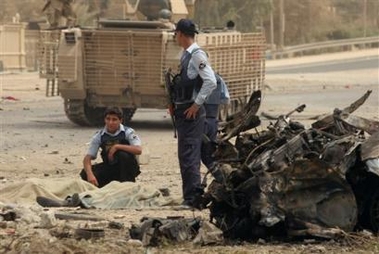 M113A3 Gavin???
M113A3 Gavin???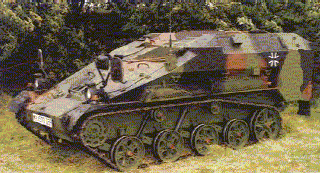 Wiesel 2???
Wiesel 2???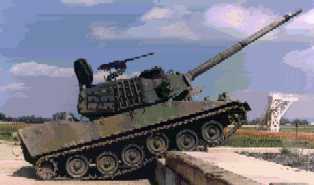 M8 Buford AGS???
M8 Buford AGS???
The Deja-view from 1959, read it and weep...
Fileroom Folder: 1950-1959/ 1959/ VOL XXXIX, NO. 05 - AUGUST 1959/ 03, OGORKIEWICZ, Richard M. : AIRBORNE ARMOR -- AUGUST 1959/U.S. Army Military Review
The limited progress with air-transportable armored vehicles is all the more unfortunate as they were shown to be a practical proposition more than 20 years ago. [60 years ago to today's reader].
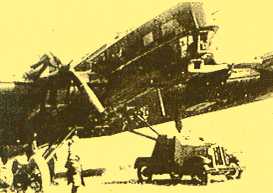
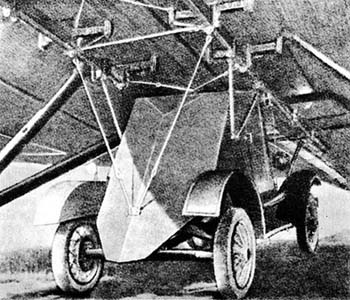
It was in the mid-thirties during maneuvers, in fact, that the Russians demonstrated with T37 amphibious light tanks and their four-engined transport/bombers.
See the early Russian Airborne in action in web page video clips here! AWESOME!

During 1931, the eight amphibious Carden-Loyd tankettes which had been purchased in England under the 1931 negotiations were used as the basis for a new light amphibious tank. A prototype was completed at AMO in 1932 and was designated "Morskoi 33". This first prototype of the T-33 weighed 3 tons and had a two-man crew. Armed with a single 7.62mm DT MG in a 360 degree traverse turret, its armour varied from 7-9 mm. A petrol engine provided 63hp and gave the vehicle a maximum speed of 28mph. A second prototype of the T-33 was fitted with an improved suspension and a new armour arrangement.
The new suspension was a modified Horstmann scissors type which replaced the original Carden-Loyd suspension which was found to be unsuitable for Russian terrain. The second prototype was completed in 1933, and was designated T-37 plavaiushchiya (amphibious) tank. The hull configurations was almost identical to that on the original Carden-Loyd tankette. New changes was the turret fitted to the left, and the modified tracks and propeller drive systems. The exterior of the vehicle was strengthened against wave buffeting. The early production models, believed to have been designated 3-2T, had small welded turrets with flush tops, similar to those fitted on the T-26A. During the Finnish Winter War these were replaced by a larger and roomier turret with a raised hatch cupola. The vehicle had a single propeller and rudder fitted on the rear hull, with a power takeoff from the engine for the propeller. Encased in sheet metal, balsa-wood floats were fitted in form of trackguards to provide additional buoyancy to the watertight hull. The engine was cooled by air from a large fan housed in a riveted box, built on the rear deck of the tank. With the driver seated to the left of the turret, the engine was placed to the right in the rear. The sprockets and final drives were at the front, drive being transmitted from the engine at the rear, via carden shafts passing under the crew compartment to the gearbox at the front of the vehicle. Through a differential to the final drives, direct drive was taken from the gearbox. The gear-changing and steering methods were identical to those adopted on the T-27 tankette. No radio was fitted in the T-37, except for the command version, T-37U, which adapted a large frame aerial around the hull. The Russians had a hard time to form a watertight seal on this tank, due to its riveted construction, and production ceased after only 70 vehicles had been built.
A modified version, designated T-37A, was built during 1935 with thicker die-formed armour plates welded and riveted, making the tank a bit heavier. The T-37A had abandoned the balsa floats on the trackguard. Another project was undertaken with the SU-37, armed with a 45mm Model 1932 L/46 gun. When production finally ceased in 1936, a total of 250 T-37s and T-37A had been built by AMO in Moscow. Both models were issued to reconnaisance units of the infantry, cavalry and mechanized formations during the 1939-41 campaigns against the Finns and the Germans.
Specifications T-37:
Crew: 2
Armament: 1 x 7.62mm DT
Ammo: 2.142 DT rounds
Armor: 4mm - 9mm
Weight: 3.250kg
Engine: GAZ-AA, 70hp
Speed: Road - 35km/h, Water - 6km/h
Length: 3.73m
Width: 1.94m
Height: 1.84m
Range: 185km
Lightweight tanks and other battleworthy air-transportable mechanized equipment must be developed now in order to meet the growing require-ment for effective combat units with aerial mobility and weapon power that armored vehicles could be delivered by air. However, the Soviet Army failed to make any use of air-transported tanks during World War II, as it failed to make effective use of its large Airborne forces. [Stalin killing all the Soviet Airborne's senior leadership caused this]
Before Stalin killed off his Airborne "brain trust" they had solved the air-delivery of light tanks in many ways. One way was to make the light tank itself a glider. In late 30's idea of an Airborne insertion of combat vehicles behind enemy lines appealed to the military commanders of several countries. Light tanks "falling" from the skies would be unexpected and nasty surprise for enemy and perhaps that little extra push which make a difference between a victory and defeat.
Russians were experimenting with large bombers: combat vehicles were embedded into bomb bay of the aircraft, so it has enough clearance to take off. German approach was different: they were building large gliders, capable of hauling small combat vehicles and even light tanks.
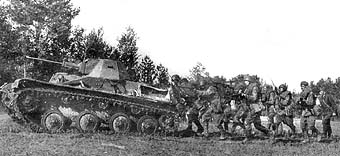
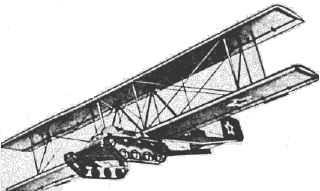
The glider had an unorthodox control system: an inclination of the gun was slaved to the tail surface (pitch control) and rotation of the turret was used to change the roll. Prior to landing, a pilot/tankist would start the engine and speed up the caterpillar, so that KT-40 can land.
However no KT-40 went into production after Stalin's purge of innovative military leaders who could be rivals to him politically.
The Germans, who took the lead in Airborne warfare at the beginning of World War II, also made no use of armored vehicles in their Airborne operations. The successful German operations in Norway and in Holland in 1940 did, however, provide a powerful stimulus to the Anglo-American development of Airborne forces which incorporated plans for Airborne tanks almost from the start.
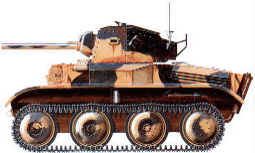
Tetrarch was a light and fast tank, that was proposed for Airbone troops. It's 165 h.p. "Meadows" engine and original chassis provided it with high speed - up to 64 km/h. It had 40mm gun and a machine-gun - quite good armament for such class of a vehicle.
Specifications:
Crew: men 3
Weight: kg 7 620
Lenght: m 4.3
Width: m 2.3
Height: m 2.1
Armor: mm 4-16
Armament: 1 x 2 pdr
7.92 mm: 2025 rounds
Engine: "Meadows" MAT, 12-cylinder petrol, 165 h.p.
Range: km 224
Max. speed: km/h 64
In Britain it was decided early in 1941 to use the contemporary 40-mm gun Tetrarch light tank and to develop for it a special heavy glider-the Hamilcar. At about the same time, in February 1941, the United States began the development of the T9 air-transportable 37mm gun tank which evolved into the M22.
M22 Locust: Glider airlanded by 17th Airborne during Operation "Varsity" the Rhine river crossing in 1945
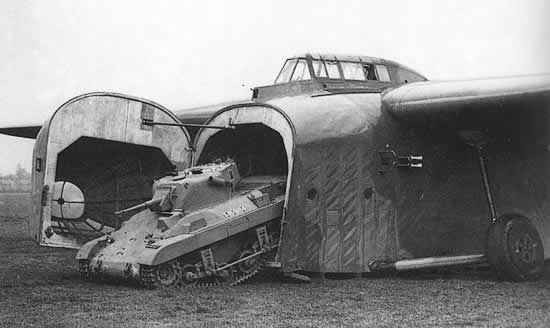
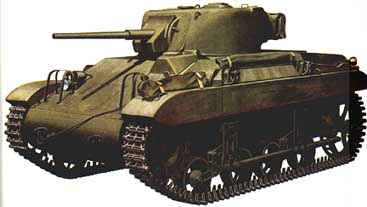
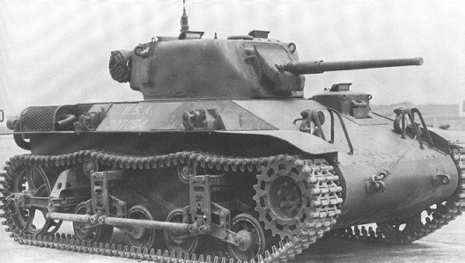
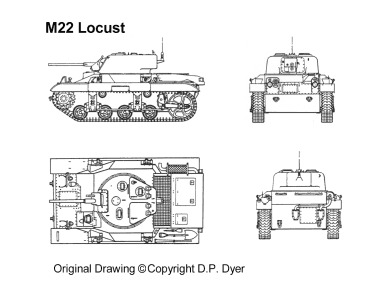
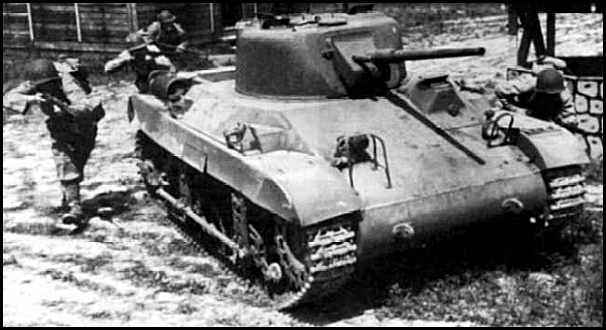
Unfortunately, the far-sighted decision to develop a light air-transportable tank was not matched in time by the development of an aircraft capable of carrying the M22. In consequence, when the opportunity came for the use of Airborne tanks in the large-scale three-division U.S.-British Airborne landings on D-day in Normandy in June 1944, only the Tetrarch [and Bren Gun Carrier] was used. And even then only seven actually were landed, by Hamilcar gliders, as part of the reconnaissance battalion of the British 6th Airborne Division, They proved useful but they were too few in number and too lightly armed to produce really significant results. No Airborne tanks were used in the next Airborne operation at Arnhem, but United States-built M22 tanks were used by the British 6th Airborne Division in the last major Airborne operation of World War II-during the crossing of the Rhine in March 1945.

Eight x M22's actually were carried in Hamilcars, but only two survived the flak and the landing fit for action. Thus the employment of Airborne tanks during World War II was extremely limited.
CORRECTION: Robert's armory excellent web page on the M22 states:
Experiments were even conducted carrying Locusts under C-54 transport planes...
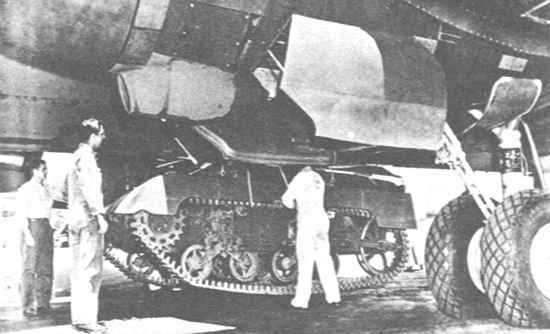
"Development of the M22 continued by the Ordinance Department, but engineering problems dealing with excessive weight and poor performance were encountered. Testing showed the impracticalities of utilizing American aircraft at that time. Hoisting the tank hull under a C-54 cargo plane and placing the turret in the plane proved cumbersome and time-consuming. Because of the lack of a good air delivery system and disappointing performance of the vehicle, the Ordinance Department became less enthusiastic for any further development. However, the British were still interested in the vehicle and 260 were delivered with the remaining vehicles utilized for training purposes in the U.S. The British were more active than the U.S. in Airborne tank development having Airborne tanks of their own such as the Tetrarch, Alexto and Hopkins. The British outfitted the 37mm guns with an extruder adapter (squeeze-bore) that reduced the projectile from 37mm to 30mm increasing velocity to 4000 ft/sec from 2700 ft/sec. A new high mass and shatter resistant tungsten carbide ammunition was developed for this application. Twelve of the tanks were landed using the giant Hamilcar glider during the Rhine crossing on March 24, 1945. The British airborne crossing of the Rhine river, called Operation Varsity, utilized over 50 large Hamilcar Gliders delivering Airborne tanks and other equipment for the 6th Airborne Armored Reconnaissance Regiment, Royal Armored Corps, of the British forces. One Locust tank was credited with killing over 100 enemy soldiers".
The principal reason was the shortage of suitable transport aircraft. Only 50 Hamilcars were available for the 1944 landings in Normandy and up to the end of the war there still were no other aircraft in service capable of delivering the Tetrarch or the M22.
In contrast, the major problem since World War II has been the lack of suitable tanks. The standard United States C-82 tactical transport of the post-World War II period was quite capable of carrying the 15,600 pound M22, but the latter, and the equally undergunned British Tetrarch, were already virtually obsolete when they were first used in Airborne operations. The M24 light tank was more powerful and at 38,750 pounds could be carried in the C-124 Globemaster I strategic transport, but in the late forties its 75mm gun armament no longer was adequate while its more powerfully armed successor, the M41, ruled itself out from the Airborne field by weighing 50,000 pounds.
French Light Tanks
Only the French Army had the foresight in 1946 to conceive a well-armed air-transportable tank- the AMX-13. Although too heavy for such tactical transports as the C-119 and C-123, and the French Novd 2501 Noratlas, the AMX has been carried successfully in the Bregurt 765 Saltara and is within the carrying capacity of such more recent transports as the
C-130 Hercules and the British Lleucrlcy. Thus by the mid-fifties the AMX acquired the distinction of being the only battle-worthy air-transportable tank in service. It was only after the prototypes of the AMX appeared that the somewhat similar
T92 air-transportable tank was designed in the United States. A little earlier came the 1949-specified T1O1 Airborne self-propelled gun, since standardized as the M56, At about the same time the Soviet Army also introduced into service an air-transportable 57mm self-propelled anti-tank gun.

Rigged for Parachute Airdrop

Helicopter Sling-Load
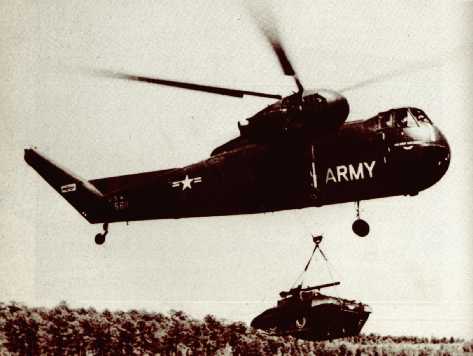
The adoption of the M56 and its integration into the Airborne Divisions is a welcome step forward in the direction of air-transportable mechanized weapons. But for all its virtues, the M56 barely touches upon the numerous possibilities in this field and its development was none too early.
The slow progress since World War II in the field, of air-transportable mechanized weapons has been due largely to an unwillingness to depart" from the established trends toward "bigger and better" tanks and to reconsider the entire problem of armored vehicles in terms of the basic need of Airborne forces for mobile weapon power. A few Airborne enthusiasts advocated the development of lightweight air-transportable tanks, but in general little was done about bringing armored vehicles into Airborne operations. It was converted to such far-fetched schemes as the transport of 100,000-pound medium tanks of the M46 class in experimental giants of the C-99 type, instead of trying to develop lightweight vehicles within the 16,000-pound carrying capacity of the standard assault transports.
Current Trends
Admittedly, the problem of developing such lightweight air-transportable commonly held that lightweight lightly armored combat vehicles would be at too much of a disadvantage in relation to the conventional types which could afford much thicker armor. In consequence, the two organic tank Battalions of the United States Airborne Divisions were equipped with relatively heavy standard-type tanks which made them surface-bound and perforce relegated them to the ground followup echelon. As a further consequence of this state of affairs, in the late forties attention was directed towards air-delivered vehicles; it was not easy but the difficulties were not insurmountable. A solution to the problem of mounting sufficiently powerful conventional guns in light vehicles appeared as early as the closing stages of World War II in the shape of recoilless guns. Some of the potentialities of recoilless gun armed armored vehicles have been indicated since by the Ontos which has been adopted by the united states marine corps and which has been successfully parachuted from C-130 Hercules. More recently, even greater opportunities for the development of powerfully armored lightweight vehicles have appeared with the introduction of short-range surface-to- surface guided missiles, such as the French SS-10 and SS-11. With armament of this type capable of penetrating 16 to 19 inches of armor, light air-transportable vehicles are feasible which can destroy the most heavily armored hostile tanks and which thus can provide the answer to the most dangerous threat that Airborne units have had to face so far. At the same time, the armor-piercing performance of the antitank guided missiles (ATGMs) re-emphasizes the futility of trying to develop heavily armored air-transportable tanks while the case for light armored vehicles is further reinforced by the needs of the missiles themselves. For optimum effect the short-range guided missiles need to be integrated into mobile weapon systems and this calls for highly mobile launching platforms such as suitably designed combat vehicles.
Lightly armored fully tracked vehicles could weigh as little as 4,000 pounds. Yet in spite of their lightweight, such vehicles could carry powerful armament. In consequence, there now is a definite possibility of providing battleworthy air-transportable combat vehicles and thus giving Airborne forces the mobile weapon power which they have lacked so far.
In the meantime, even lightly armed air-transportable armored vehicles have shown their worth. For instance, when the first serious trouble occurred in the British Aden Protectorate in 1955, a troop of Ferret light armored cars rapidly delivered by air provided a valuable complement to air-transported rifle units.
Conclusion
There is no doubt that air-transportable armored vehicles would have been very useful in many operations. In the light of this and the technological possibilities there is every reason for greater effort in the development of lightweight tanks and other air-transportable mechanized equipment. Without it Airborne troops will continue to be handicapped and unable to meet fully the growing requirement for effective air-transportable ground combat units.
"We envision the time when the individual Soldier will be equipped with almost unbelievable firepower. He will go into battle with weapons and equipment that just a few years ago were to be found only in science fiction, yet today are on the drawing boards or approaching the prototype stage. The future fighting man may have a two-way helmet radio, and with television and infrared equipment; he may ride a flying platform or an aerial jeep; and he may carry in his individual shoulder weapon the thunderbolts of atomic firepower."
-- Lieutenant General Arthur G. Trudeau
SUMMARY/CONCLUSION
We have thousands of 11-ton M113 Gavin light tanks available for use by our Army Airborne that can be parachute dropped and STOL airlanded by USAF C-130 and C-17 fixed-wing transports. They can even be CH-47D/F helicopter sling-loaded for air assaults. 17-ton M8 Buford 105mm gun and 120mm Thunderbolt light tanks are also available.
We could develop a platform with glider wings to TOW these light tanks by USAF transports as Kelly Aerospace is developing a sub-orbital aerospace plane that will be towed by a 747 then released.
This way, the USAF transports or cargo 747s could carry a load inside, too doubling our airlift capabilities. Tank futurist Ralph Zumbro writes:
"Remember the tracked P-40, and other aircraft? If we came up with something like a new Universal Carrier based on the Gavin or Lynx chassis, it could have a wing kit and could land on its own tracks. HOWEVER, they'd have to be run up to ground speed under power just before touchdown or things could be a bit messy. The concept would, however, get Armor on the Airhead fast, cheap, and simple. Carriers that could glide in could actually be released over the horizon, and simply glide down on roads or level fields.....If the buggers were amphibs, they could land on the Tigris...or the Amazon or wherever."
Lighter 4-7 ton Wiesels or Bv206Ss are available at low cost (under $600,000 each) that will fit inside CH-47D/Fs for roll-on/roll-off helicopter air assaults.
No Airborne/Air Assault tanks?
No excuse!
FEEDBACK!
"Been looking over some of the stuff you have put up on light tanks-depressing stuff -makes you want to fly off to Rus with a plane full of levis and buy up all of the russian stuff.
The bit about the flying glider tank is interesting -I'd come across the same idea but suggested by Willy Messershmit when the germans wanted to come visiting -I think the german system used a set of skids under the tracks, and the idea was to fit mounting brackets on Pz 3 and 4s.
Bit of nitpicking about the Bren carrier -it was a different beastie to the Carden lloyd (originally a vickers desigh, I'll have to check). Bren and Universal carriers were actually different vehicles (though looked the same from the front) The true Bren carrier had a seat in the rear for the third crewman (another gunner) and sloped at the back. The universal has a boxed back and room for more men and gear. The germans called both types "Bren" for the models that they operated (which were captured). The Italians also operated them and also made there own version. The U.S. also made a slightly bigger version of the universal, which I think was called the T16-nearly a chop-top M113!
Many later universals (which nearly totally superseeded the true Bren) carried a 2"mortar as armament in addition to the Bren gun (though aussie versions often mounted a vickers -there was also a vickers carrying vehicle called the MMG carrier, with the gun mounted over the engine). Often universals were upgunned -biggest field modification I've seen was a 20mm gun mount. There is an old (but very interesting) book on the british carrier story up to 1972 called "Making Tracks"
Lastly an idea that is still half formed -a turret roof mounted RR that drops down to allow the breech to be loaded under cover -such should fit on a M113, maybe in a multiple mounting
phil